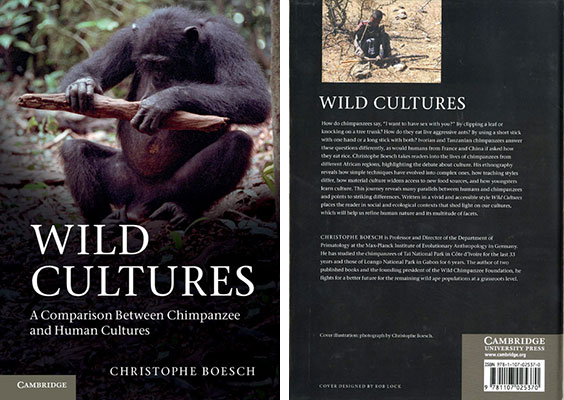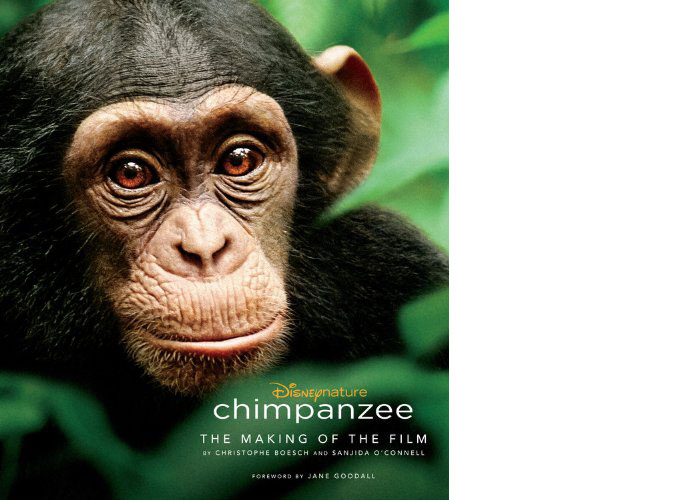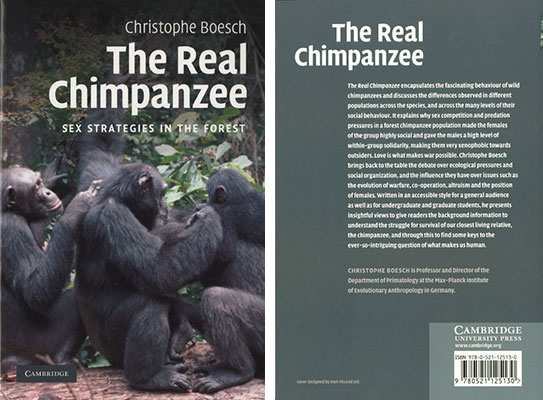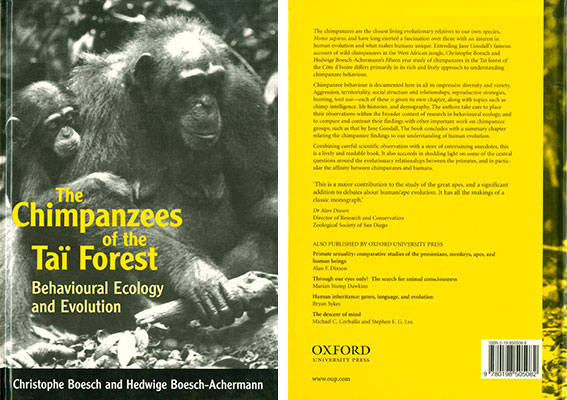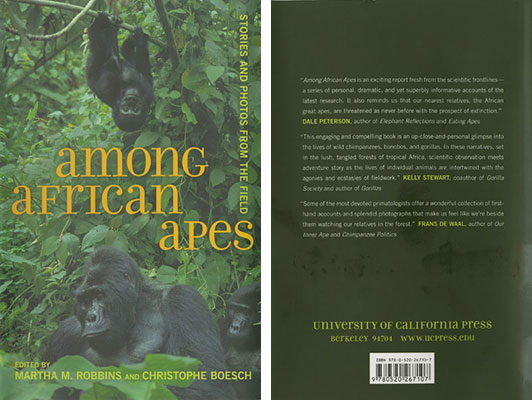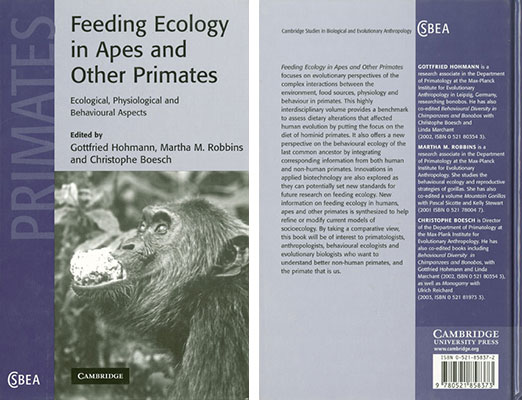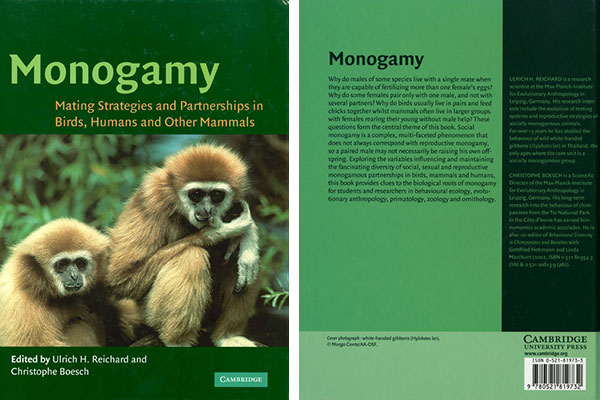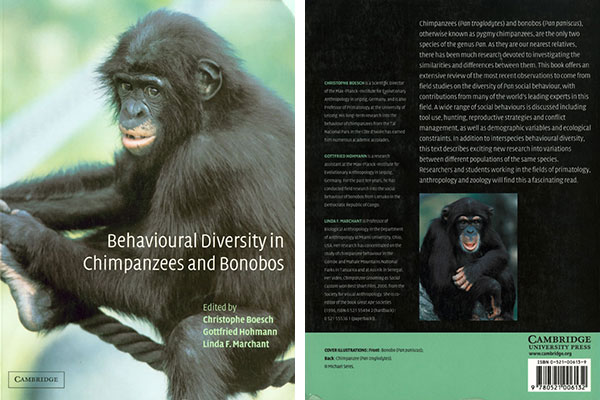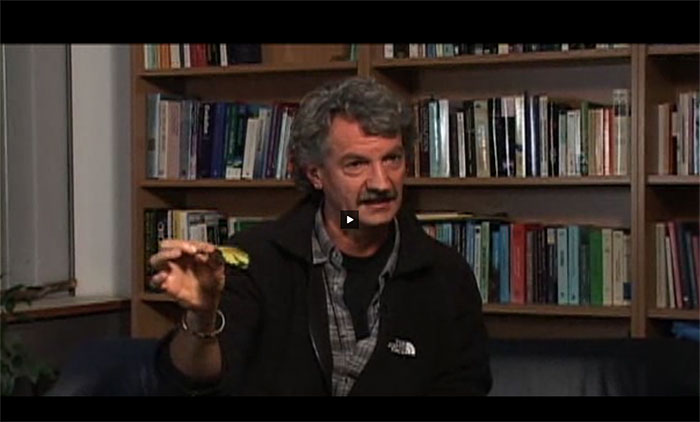Prof. Dr. Christophe Boesch
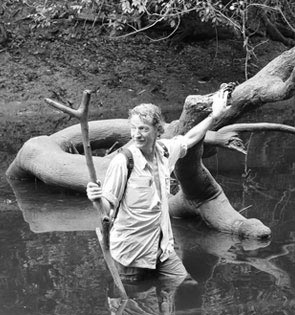
With deep sadness the Max Planck Institute for Evolutionary Anthropology (MPI-EVA) in Leipzig announces that Prof. Dr. Christophe Boesch passed away suddenly on 14 January 2024 at the age of 72.
As one of MPI-EVA's founding directors and as director of the former Department of Primatology, Christophe Boesch made significant contributions to the establishment and management of the Institute since 1997. His passion was the study of the cultures of the great apes as well as the protection of their remaining habitats. He spent a major part of his life in Africa's forests studying the behavior of chimpanzees. Hardly anyone knew them better than he did. He made great contributions to the preservation of chimpanzees in the wild.
Christophe Boesch's work in science and in conservation, especially the protection of wild chimpanzees, is an inspiration for us all. His passing is a shock to his colleagues near and far. We are grateful for his commitment and his friendship, and will honor our "chimpanzee man" and his legacy to the very best of our abilities.
Our deepest sympathy goes out to his family, friends and colleagues.
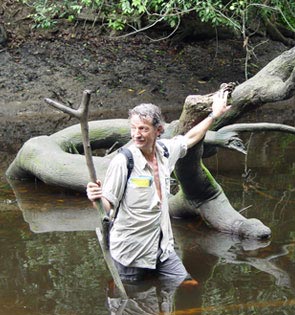
Director Emeritus
Max Planck Institute for Evolutionary Anthropology
Department of Primatology
Deutscher Platz 6
04103 Leipzig, Germany
Research
A complete understanding to what makes us humans will emerge only from a better knowledge of the full range of the understanding, competence and capability of our closest living relative, the chimpanzee. Too often claims of human uniqueness have been based on incomplete knowledge of what chimpanzees are or were based on chimpanzees living in unnatural captive conditions. To allow for a sound comparison of humans and chimpanzees, I have concentrated in my research on chimpanzees and humans living in their natural environment and solving natural challenges in their daily life. Recently, we have worked to deepen our comparative analysis of chimpanzee and bonobo differences, and implemented an ambitious project throughout Africa to increase our scant knowledge of behavioral, technical and biological differences in chimpanzees.

In recent years, I have developed an extensive approach to some of the questions I have been working on for decades to broaden our understanding of the breadth of the cultural diversity in wild chimpanzees, and in deepening our understanding of the technical intelligence skills in humans and chimpanzees. To be able to move forward on these important questions, I have been specifically working on the following areas:
1 – Cultural diversity in chimpanzees
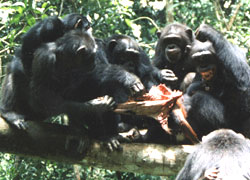
The large “PanAfrican Chimpanzee Program” focuses on studying chimpanzee culture from all four Pan troglodytes subspecies from over 38 temporary research sites across Africa (http://panafrican.eva.mpg.de) . The program takes a holistic approach to studying chimpanzee culture and combines modern approaches like video camera traps and samples for genetic, pathogen and isotope analysis with traditional field approaches such as transects, phenology and habitat structure. The data generated by the project will have broad implications for the conservation of African primates and other sympatric species, as well as understanding the population history of chimpanzees and the factors currently affecting their distribution and survival.
Thanks to the extended video library we accumulated in the PanAfrican chimpanzee program, I have been able to analyze in detail different technical solutions adopted by different chimpanzee populations when fishing for termites from underground or aboveground nests. The technical constraints of termite fishing is limited so that individuals have the possibility to select different materials, body position and grips to fish for termites according to different nest structures. This opens the way to distinguish alternative strategies and see how much they are either due to ecological factors, or culturally based. We uncovered an impressively large number of different solutions in the populations, which emphasizes that we are still greatly underestimating behavioral and cultural diversity in chimpanzees.
2 – Technical intelligence in humans and chimpanzees
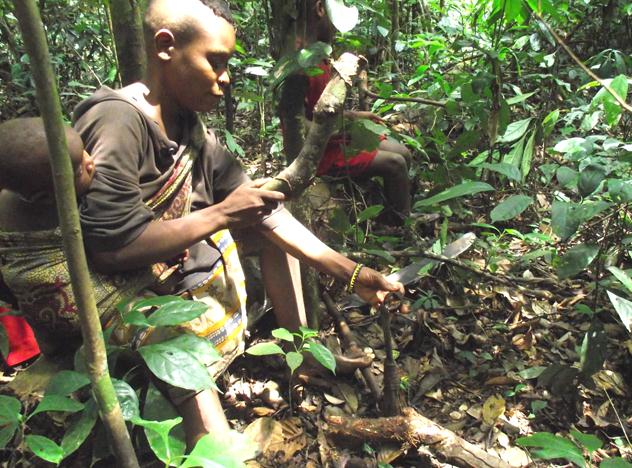
Many studies comparing humans with chimpanzees are weakened by important differences in the way the two species are compared, mainly because the chimpanzees are too often living in captivity under unnatural conditions. Since it often very difficult to ascertain which of the many differences are responsible for any differences observed, we are too often left wondering what one can conclude from such studies. In an attempt to overcome such biases I initiated several comparative studies.
In a first study on technology use, I followed the Mbendjele and Aka forest hunter-gatherers in the forest of the Central African Republic and the Republic of Congo, as they cracked open nuts of the same or very similar species as I studied in the Taï chimpanzees. This allowed us for the first time to directly compare humans and chimpanzees naturally performing a very similar technique, avoiding thereby the artificiality and arbitrariness of many comparative studies. In the first analysis, I compared the adult female techniques of the three groups (Boesch et al. in press) and could see that women, thanks to their human specific tools, could gain access to nuts that the chimpanzees cannot exploit. On the other hand, for the same type of nuts, chimpanzees proved surprisingly efficient and were by some measures more efficient that humans. This shows clearly that chimpanzee possess some high level of technical intelligence and can solve technical problems in ways similar and complementary to those of humans.
In a second study, we will be looking at the acquisition of the nut-cracking skills in youngsters by comparing the Mbendjele people with the Taï chimpanzees and compare maternal interventions in the learning process of the youngster and if they contribute to make the learning more efficient and more rapid. In both species, it takes many years to reach adult proficiency and this lengthy learning process should allow us to uncover more of the development of this technique.
In collaboration with Karline Janmaat and Haneul Jang we are evaluating the spatial skills of the Mbendjele people as they forage for fruits, tubers, nuts and honey in the forest and will compare with very similar methods to our studies of the spatial skills in Taï chimpanzees. Thus in two different cognitive domains, are we going to be able to compare the two species in a natural context.
3 – Tool use in wild chimpanzees
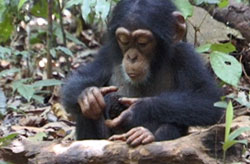
Tool use has been a key benchmark for humanity and therefore study of tool use in animals is of special relevance. In recent years, my efforts have been encompassed three different directions:
- Document new tool use types: Using the important video material we collected on 38 different and new chimpanzee populations in the context of the “Pan African Chimpanzee Program”, we have come upon totally unknown tool use behavior that we were able to describe in some details. The first was stone throwing and accumulation that we discovered in some West African chimpanzee populations (Kühl et al. 2016), whereby they throw stones at tree trunks during their pant-hoot display and in some cases this results in the accumulation of stones within the tree trunk. The second was algae fishing with long sticks from deep in the water of small rivers that we discovered in chimpanzees from Guinea (Boesch et al. 2016).
- Follow the learning skills: With two projects are we going to address the question of maternal interventions in the learning of tool use in chimpanzees. First, Katie Corogenes is focusing on nut cracking by detailing all the interactions between mothers and infants from video recordings done over three seasons. Second, Vittoria Estienne is analysing data collected with video-traps from the unhabituated chimpanzees of Loango National Park in Gabon to see how much mothers actively or passively influence the learning by offspring. Both projects will provide insights into the interaction between teaching and learning in chimpanzees.
- Documenting tool-use complexity: Nut-cracking has been proposed to be one of the most complex forms of tool use in animals, and with Giulia Sirianni, we have been documenting very precisely how chimpanzees select and use their tools in the forest. Although potential hammers are over-abundant in the forest, chimpanzees optimally select their hammers by responding conditionally to the situation by considering five different physical properties (Sirianni et al. 2015). Such complex tool selection was not found in capuchin monkeys (Visalberghi et al. 2016). The extraction of honey from underground hives in Loango chimpanzees in Gabon also revealed a surprising flexibility and complexity that seemed unsurpassed when comparing with all other tool use known in chimpanzees (Estienne et al. 2016, in revision).
4 – Conservation and Conservation Biology
When working in Taï national park, I realized directly how the forest has become an island within a large cocoa and coffee plantation and that the forest would disappear without actions to promote its protection. Because of the need to have an NGO active in West Africa and specifically aimed at helping the chimpanzees, I created the wild chimpanzee foundation. Please visit www.wildchimps.org to see in detail what we are doing to help.
At the same time, too often conservation is done without the knowledge of animal population abundance and the impact of conservation measures. Presently, we are trying to develop a new method based on camera-traps to follow more precisely population trends in large mammals, including chimpanzees, My student, Noémie Cappelle, is for one year collecting very precise data in the Taï National Park to provide the necessary information for a robust and precise method that will allow then to guide our conservation activities.
Large populations are becoming rarer to find and so we are faced with the challenge of assessing the feasibility of conservation projects targeting fragmented populations. In Guinea, chimpanzees are still quite frequent but often in very fragmented populations. Is it possible to protect them? When yes, what type of fragments and actions should we perform. My student, Marie-Lyne Despres-Einspenner, is going to look into these questions.

Conservation
Western African chimpanzees are badly threatened across their natural range and declared as critically endangered
The work of the Wild Chimpanzee Foundation that I founded in 2000 is becoming more important and we have concentrated our effort recently in promoting new protected areas to protect some of the few remaining but essential chimpanzee populations in Cote d’Ivoire, Liberia and Guinea. All scientific studies show convincingly that protected areas are the best strategy towards effective protection of great ape populations throughout their range.
Please click on www.wildchimps.org to learn more about the conservation activities the WCF is implementing to help wild chimpanzees and to find out how you can help protect them too!
Curriculum Vitae

Personal
Date of Birth: 11-08-51 in St Gallen, Switzerland
Nationality: French and Swiss
Marital status: Married, two children (1983, 1988)
Languages: French, English, German
Education
| Secondary school | 1965-68: Lycée François Villon, Paris 1968-70: Collège Calvin, Genève degree: Maturité scientifique. |
| University of Geneva, Switzerland | 1970-75: Faculty of Biology, Diplôme de biologiste, 1975: supervisor: Prof. Hans Huggel |
| University of Zürich, Switzerland | 1979-1984: Department of Ethology and Wildlife Research Ph.D. degree, 1984: Title: "Nut-cracking behaviour of wild chimpanzees", supervisor: Prof. Hans Kummer. |
| University of Basel, Switzerland | Habilitation degree (Privat Dozent): 1994. supervisor: Prof. Stephen Stearns. |
Professional experience
| 1973 | 3 months of census work on the Mountain Gorilla in the Virunga National Park, Rwanda. Supervised by Dr. Dian Fossey. This work was the basis of my diplom master thesis. |
| 1975 and 1977 | Teaching biology at a secondary school, Collège Moderne, in Geneva. |
| 1976 | 8 months in the Taï National Park, Ivory Coast, for a preliminary study of the nut-cracking behaviour of wild chimpanzees and an evaluation of the feasibility of a long-term study. |
| 1978 | 4 months assistant at the Department of Ethology and Wildlife Research (Prof. Hans Kummer) at the University of Zürich. |
| 1979-ongoing | Long-term study of the wild chimpanzees in the Taï National Park in the Ivory Coast. Principal themes under study; ecology, social organisation, tool-use, hunting, cooperation, food-sharing, inter-community relationships, cognitive capacities. |
| 1984-1990 | Postdoctoral Research Associate at the Department of Ethology (Prof. Hans Kummer) at the University of Zurich. |
| 1987-1989 | 4 months visit at the Department of Population Biology (Prof. Stephen Stearns), University of Basel. |
| 1990 and 1992 (April to July) | Comparative field study on the chimpanzees of Gombe Stream National Park, Tanzania. |
| January 1991- September 1997 | Assistant professor at the department of Population Biology (Prof. Stephen C. Stearns), University of Basel (Switzerland). |
| 1995 Spring | Visiting Professor, University of Rennes, France. |
| 1996 Spring | Visiting Professor, Ecole Normale Supérieure, Paris, France. |
| 1997- ongoing | Director, Max Planck Institute of Evolutionary Anthropology in Leipzig, Germany. |
| 1999 (August to October) | Comparative field study on the chimpanzees of the Mahale Mountains National Park, Tanzania. |
| 1999- ongoing | Honorary Professor, Dept. of Zoology, University of Leipzig, Germany. |
| 2000- ongoing | Founder and President of the Wild Chimpanzee Foundation. |
Teaching experience
| Directing field work of students: | Diplom thesis: 16 students of different European universities. Ph. D. thesis: 24 students from European and American universities. Post-doctoral work: 8 students from European universities. |
| Teaching at the University of Basel: | Spring 1991: Behavioural Ecology of Primates (2 hours per week). Winter semester (1991- 1997): Evolution, Ecology and Behaviour (4 hours per week). Behavioural Ecology and Sociobiology (2 hours per week). Seminar on Population Biology (1 hour per week). Summer semester (1992-1997): Field course in Population Biology (2 weeks). Field course in Evolutionary Biology (1 week) |
| Teaching at the University of Leipzig: | Summer semester (1999-ongoing): Behavioural Ecology (2 hours per week) |
Offices and advisory work
- Fyssen Foundation, Paris, scientific board member (1985-1989)
- World Wide Fund for Nature International (WWF Int.): Consultant to negotiate with the Ivorian government a conservation project for the Taï National Park (1987-1988).
- World Wide Fund for Nature International: Coordinator project in the Taï National Park, Ivory Coast (1988-1992).
- Committee for the Care and Conservation of Chimpanzee (CCCC), executive council (1988-1992)
- Society for the study of Animal Behaviour, Member (1993-1998)
- IUCN/SSC Primate Specialist Group (1986-ongoing)
- International Primatological Society (1986-ongoing)
- International Primate Protection League (1986-ongoing).
- International Journal of Primatology, Editorial Board (1990-2004).
- Behavioral and Brain Sciences, Associates (1991-ongoing)
- Pan Africa News, Editorial Board (1997-ongoing)
- Steering Committee of the World Heritage Species Status Taskforce, Member (2002-ongoing)
- IUCN/SSC/ Section of the Great Apes (SGA), Excecutive Committee Member (2003-ongoing)
- Co-chairman of the Scientific Committee of the Great Apes Survival project (GRASP) of the UNEP/UNESCO (2003-ongoing)
Grant reviewer: NIH, National Science Foundation (USA), Swiss National Science Foudation, Leakey Foundation, National Geographic Society, Fulbright Foundation, Wenner-Gren Foundation
Ad Hoc Reviewer: Behavioural and Brain Sciences, Animal Behaviour, Nature, Behaviour, Ethology, Primates, International Journal of Primatology, American Journal of Primatology, Folia Primatologica, American Journal of Physical Anthropology, Current Anthropology, Behavioural Ecology, Proceedings of the National Academy Science, Serie B, Quaterly Review of Biology, American Naturalists, Journal of Human Evolution, Proceedings of the Royal Society: Biological Sciences, Journal of Evolutionary Biology.
Awards and other honours
| 1985 | Prix Cortaillod for talented Swiss scientists under 35 years old, University of Neuchâtel, Switzerland. |
| 1987 | Great Apes Fellowship of the Leakey Foundation, Pasadena. |
| 1989 | Great Apes Fellowship of the Leakey Foundation, Pasadena. |
| 1999 | Phillip Morris Research Price, München. |
| 2013 | Medal "Officier de l'Ordre National" by the president of Côte d’Ivoire Alassane Ouattara 2013 |
| 2015 | Prof. Boesch and the Wild Chimpanzee Foundation received the St. Andrews Prize for the Environment. |
Publications
Books

Publications
1996
Boesch, C. 1996. Social grouping in Taï chimpanzees. In Great Apes Societies (Eds. W. McGrew., L. Marchant and T. Nishida), pp. 101-113. Cambridge: Cambridge University Press.
Boesch, C. 1996. Three approaches for assessing chimpanzee culture. In Reaching into Thought: The Minds of the Great Apes (Eds. Russon, A. E., Bard, K. and Parker, S.T.). pp. 404-429. Cambridge: Cambridge University Press.
Boesch, C. 1996. The emergence of cultures among wild chimpanzees. In Evolution of Social Behaviour Patterns in Primates and Man (Eds. Runciman W. G., Maynard-Smith, J. and R. I. M. Dunbar). pp. 251-268. Oxford: Oxford University Press for the British Academy.
Boesch, C. 1996. The question of culture. News and Views. Nature 379: 207-208. pdf
Boesch, C. and Boesch, H. 1996. Rain forest chimpanzees: the human connection. Nature and Resources, 32(1): 26-32.
Boesch-Achermann, H. and Boesch, C. 1996. Kulturwesen, Panda Magazin 2/96, 26-31.
1995
Boesch, C. 1995. Innovation in wild chimpanzees. International Journal of Primatology 16(1): 1-16. pdf
Le Guenno, B., Formenty, P., M. Wyers, and Boesch, C. 1995. Isolation and partial characterization of a new Ebola strain. The Lancet 345: 1271-1274. pdf
Marchesi, P. Marchesi, N., Fruth, B. and Boesch, C. 1995. Census and distribution of chimpanzees in Côte d'Ivoire. Primates 36(4): 591-607. pdf
1994
Boesch, C. 1994. Hunting strategies of Gombe and Taï chimpanzees. In: Chimpanzee Cultures (R. Wrangham, W. McGrew, F. de Waal and P. Heltne, Eds), pp. 77-91. Cambridge: Harvard University Press.
Boesch, C. 1994. Chimpanzees - red colobus: A predator-prey system. Animal Behaviour 47(5): 1135-1148. pdf
Boesch, C. 1994. Cooperative hunting in wild chimpanzees. Animal Behaviour 48(3): 653-667. pdf
Boesch, C. and Boesch-Achermann, H. 1994. Technique et culture chez les chimpanzés sauvages. Technique et Cultures 23-24: 1-27.
Boesch, C., Esser, J., Allefort, P., Couturier, G. and Merz, G. 1994. La Faune. In Le Parc National de Taï, Côte d'Ivoire. Tropenbos Series 8, 72-93.
Boesch-Acherman, H. and Boesch, C. 1994. The Taï chimpanzee project in Côte d'Ivoire, West Africa. Pan Africa News 1(1): 5-7. pdf
Boesch, C. Marchesi, P., Marchesi, N., Fruth, B., Joulian, F. 1994. Is nut cracking in wild chimpanzees a cultural behaviour? Journal of Human Evolution 26: 325-338. pdf
Boesch-Acherman, H. and Boesch, C. 1994. Hominisation in the rainforest: The chimpanzee's piece to the puzzle. Evolutionary Anthropology 3(1): 9-16. pdf
1993
Boesch, C. 1993. Towards a new image of culture in wild chimpanzees? Behavioral and Brain Sciences 16(3): 514-515.
Boesch, C. 1993. Aspects of transmission of tool use in wild chimpanzees. In Tools, Language and Cognition in Human Evolution, (Eds. K. Gibson and T. Imgold), pp. 171-183. Cambridge: Cambridge University Press.
Boesch, C. and Boesch, H. 1993. Different hand postures for pounding nuts with natural hammers by wild chimpanzees. In: Hands of the Primates (Eds. H. Preuschoft and D. Chivers), pp. 31-43. Wien: Springer-Verlag.
Boesch, C. and Boesch, H. 1993. Diversity of tool use and tool making in wild chimpanzees. In Use of Tools in Human and Non-Human Primates (Eds. A. Berthelet and J. Chavaillon), pp. 158-168. Oxford: Oxford University Press.
Boesch-Acherman, H. and Boesch, C. 1993. Tool use in wild chimpanzees: New light from Dark forests. Current Directions in Psychological Science 18-21. pdf
Günther, M. and Boesch, C. 1993. Energetic cost of nut-cracking behavior in wild chimpanzees. In: Hands of the Primates (Eds. H. Preuschoft and D. Chivers), pp. 109-129. Wien: Springer-Verlag.
1992
Boesch, C. 1992. New elements about a theory of mind in wild chimpanzees. Behavioral and Brain Sciences 15(1): 149. pdf
Boesch-Achermann, H. and Boesch, C. 1992. Forest close-ups. BBC Wildlife Magazine 10(1): 14-20.
Boesch-Achermann, H. and Boesch, C. 1992. Verblüffend menschlich: Westafrikas Schimpansen. Das Tier 5: 8-17.
1991
Boesch, C. 1991. Handedness in wild chimpanzees. International Journal of Primatology 12(6): 541-558. pdf
Boesch, C. 1991. Symbolic communication in wild chimpanzees? Human Evolution 6 (1): 81-90. pdf
Boesch, C. 1991. Teaching in wild chimpanzees. Animal Behaviour, 41(3): 530-532. pdf
Boesch, C. 1991. The effects of leopard predation on grouping patterns in forest chimpanzees. Behaviour, 117 (3-4): 220-242. pdf
Boesch, C. and Boesch-Achermann, H. 1991. Dim forest, bright chimps. Natural History 9/91 (50-57).
Boesch, C. and Boesch-Achermann, H. 1991. Les chimpanzés et l'outil. La Recherche, 233: 724-731.
1990
Boesch, C. 1990. First hunters of the forest. New Scientist, 19 May, 38-41. pdf
Boesch, C. and Boesch, H. 1990. Adventures in Eating. BBC Wildlife Magazine 8(10): 668-672.
Boesch, C. and Boesch, H. 1990. Tool use and tool making in wild chimpanzees. Folia Primatologica 54: 86-99. pdf
1989
Boesch, C. and Boesch, H. 1989. Hunting behavior of wild chimpanzees in the Taï National Park. American Journal of Physical Anthropology 78: 547-573. pdf
1988
Boesch, C. 1988. West African Oasis. WWF Report 8/9/88.
1984
Boesch, C. and Boesch, H. 1984. Mental map in wild chimpanzees: An analysis of hammer transports for nut cracking. Primates 25: 160-170. pdf
Boesch, C. and Boesch, H. 1984. Possible causes of sex differences in the use of natural hammers by wild chimpanzees. Journal of Human Evolution 13: 415-440. pdf
Guillaum et, J.L. and Boesch, C. 1984. Le parc national et la protection de la nature. In: Recherches et aménagement en milieu forestier tropical humide: Le Projet Tai de Côte d'Ivoire. Notes techniques du MAB 15, UNESCO: Paris.
1983
Boesch, C. and Boesch, H. 1983. Optimisation of nut-cracking with natural hammers by wild chimpanzees. Behaviour 83: 256-286. pdf
1981
Boesch, C. and Boesch, H. 1981. Sex differences in the use of natural hammers by wild chimpanzees: A preliminary report. Journal of Human Evolution. 10: 585-593. pdf
1978
Boesch, C. 1978. Nouvelles observations sur les chimpanzés de la forêt de Taï ( Côte d'Ivoire). Terre et Vie 32: 195-201.

Press
Oktober 2019
Deutschlandfunk "Ein Leben mit und für Schimpansen"
March 2017:
FRANKFURTER ALLGEMEINE SONNTAGSZEITUNG "Gefährliche Nähe" [pdf]
February 2017:
LATEST THINKING with Christophe Boesch
Interview TAGESANZEIGER ZÜRICH "Der Schimpansenmann" [pdf]
January 2016: Current Biology Magazine Feature published
April 23, 2015: 2015 Winner Announced - Chimpanzee Conservation

A multi-level conservation project, which aims to protect the largest remaining population of wild chimpanzees on the Foutah Djallon-Bafing River (FDBR) region in Guinea, West Africa has won this year’s St Andrews Prize for the Environment.
May 2013
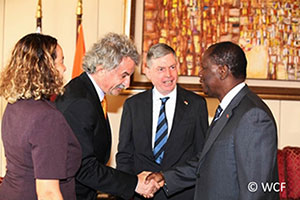
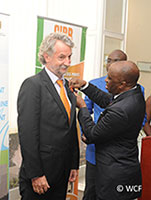
Christophe Boesch has met the president of Côte d'Ivoire, Alassane Ouattara, in February 2013 and was honoured with the medal "Officier de l'Ordre National" for his long-year investment for the conservation and research of the natural heritage in Côte d'Ivoire.
2013: Disneynature film "CHIMPANZEE"
The new Disneynature film "CHIMPANZEE" has been filmed mostly with the Tai chimpanzees we study since 33 years:
20-2-2013: The release of the film in France
03-5-2013: The release of the film in the UK
09-5-2013: The release of the film in Germany
Disney filmed the chimpanzees of the Taï National Park, Côte d'Ivoire, for three years between 2008 and 2010, under my scientific supervision and the daily help of our team in the forest. Oscar, Freddy, and Isha are all members of our chimpanzee research groups and we are all pleased that they have become stars to the public at large!
- If you want to learn more about the remarkable behavior of the Taï National Park chimpanzees, please click on www.wildchimps.org, for information on this chimpanzee population, the research and the forest where Oscar, Freddy and Isha live.
- If you want to learn more about the research we have been doing over the last 30 years on the chimpanzee of the Taï National Park, please click on my research section below or click on www.eva.mpg.de/primat/ or http://www.schimpansen.mpg.de, for information about our research and all our publications.
- If you want to contribute to the conservation of Oscar and his friends, please click on www.wildchimps.org, where you can see all the ways that your donations will directly protect wild chimpanzees.
January 27, 2010: Altruism in Forest Chimpanzees: The Case of Adoption
Max Planck researchers report 18 cases of adoption of orphaned youngsters by group members in Taï forest chimpanzees. Half of the orphans were adopted by males.
These observations reveal that, under the appropriate socio-ecologic conditions, chimpanzees care for unrelated group members and that altruism is more extensive in wild populations than was suggested by captive studies.
Download press release (pdf)
For professional press use (high resolution photos and videoclips) please contact:
Claudia Nebel (E-Mail: nebel@[>>> Please remove the text! <<<]eva.mpg.de, phone: +49 (0) 341-3550 200)
Original work:
Christophe Boesch, Camille Bolé, Nadin Eckhardt, Hedwige Boesch
Altruism in Forest Chimpanzees: The case of Adoption.
PLOSone, January 2010
Photos: Chimpanzees of the Taï National Park in Côte d`Ivoire
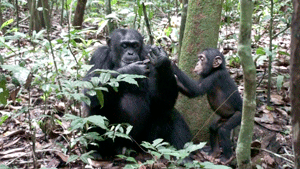
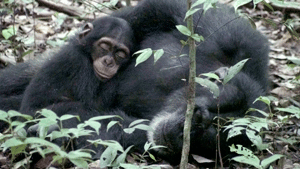
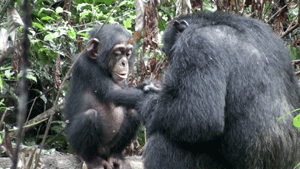
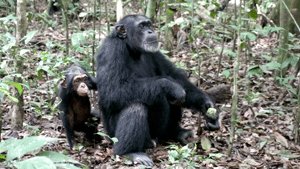
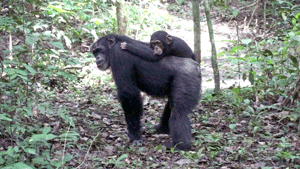
Videoclips: Chimpanzees of the Taï National Park in Côte d`Ivoire
For professional press use (high resolution photos and videoclips) please contact:
Claudia Nebel (E-Mail: nebel@[>>> Please remove the text! <<<]eva.mpg.de, phone: +49 (0) 341-3550 200)
February 13, 2007: The Chimpanzee Stone Age
Researchers have found evidence that chimpanzees from West Africa were cracking nuts with stone tools before the advent of agriculture, thousands of years ago. The result suggests chimpanzees developed this behaviour on their own, or even that stone tool use was a trait inherited from our common ancestor. Julio Mercader, Christophe Boesch and colleagues found the stones at the Noulo site in Côte d’Ivoire, the only known prehistoric chimpanzee settlement.
Download press release (pdf)
For professional press use (high resolution photos and videoclips) please contact:
Claudia Nebel (E-Mail: nebel@[>>> Please remove the text! <<<]eva.mpg.de, phone: +49 (0) 341-3550 200)
Original work:
Mercader, Julio, Huw Barton, Jason Gillespie, Jack Harris, Steven Kuhn, Robert Tyler, and Christophe Boesch
4300-year-old chimpanzee sites and the origins of percussive stone technology.
PNAS, February 2007
Photos: Chimpanzees of the Taï National Park in Côte d`Ivoire
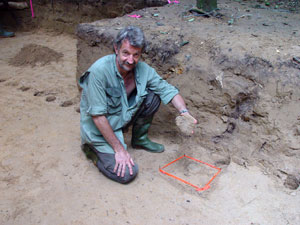
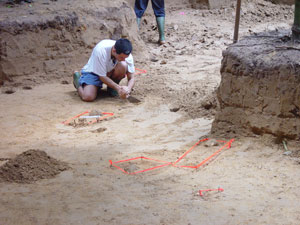
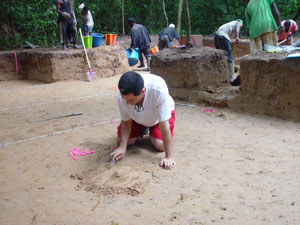
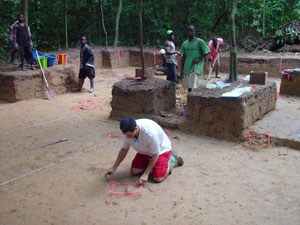
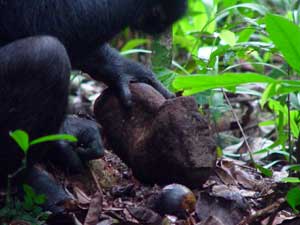
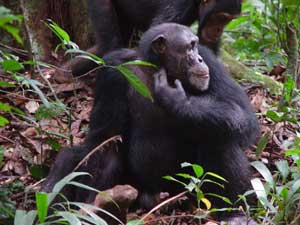
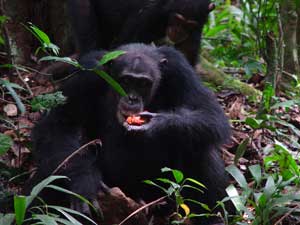
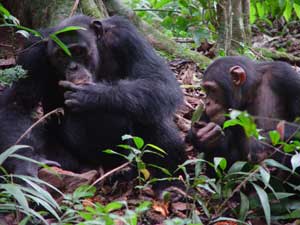
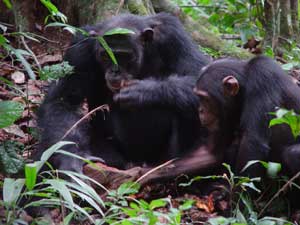
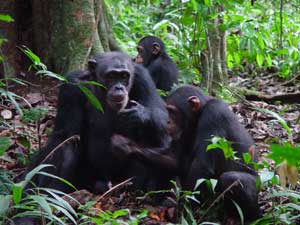
Videoclips: Nutcracking behaviour of Chimpanzees of the Taï National Park in Côte d`Ivoire
For professional press use (high resolution photos and videoclips) please contact:
Claudia Nebel (E-Mail: nebel@[>>> Please remove the text! <<<]eva.mpg.de, phone: +49 (0) 341-3550 200)
Video
Christophe Boesch explains on this video how leaf clipping contributes to our understanding of chimpanzee culture:
Doctstation: Short documentary on the PanAf Programme
Links

The Pan African Programme (PanAf)

The Pan African Programme (PanAf) ‘The Cultured Chimpanzee’ aims to overcome some of these limitations by studying a large number of populations with a cross-sectional sampling approach. It will quantify a broad spectrum of the ecological parameters that possibly contribute to generating behavioural diversity in chimpanzees and will thus also evaluate potential evolutionary scenarios to decipher central questions of human cultural evolution.
Chimp&See

Chimp&See is a web-based platform where enthusiastic amateur researchers can watch and document the contents of the PanAf remote camera trap videos. We have collected nearly 7,000 hours of footage, reflecting various chimpanzee habitats, from camera traps in 15 countries across Africa. By scanning the videos from these traps and identifying the types of species and activity that you see, you’ll help us to understand the lives of these apes – their behaviors, relationships, and environments – and to extrapolate new ideas about human origins.
Wild Chimpanzee Foundation (WCF)
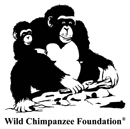
The Wild Chimpanzee Foundation is working to save between 20,000 and 25, 000 of the remaining wild chimpanzees. Current estimates suggest that there may be fewer than 100,000 chimpanzees living in seventeen different countries in Africa.
http://www.wildchimps.org
http://www.wcf-germany.com (Wild Chimpanzee Foundation - Germany)
Max Planck Institute, Department of Primatology
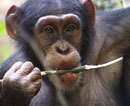
The Department of Primatology observes apes in their natural habitats, and investigates issues related to the evolution of social systems and social behavior, cultural differences and reproductive strategies in apes. The scientists are interested in fundamental cognitive processes like communication, cooperation, conflict solving strategies, social learning in apes and humans.
